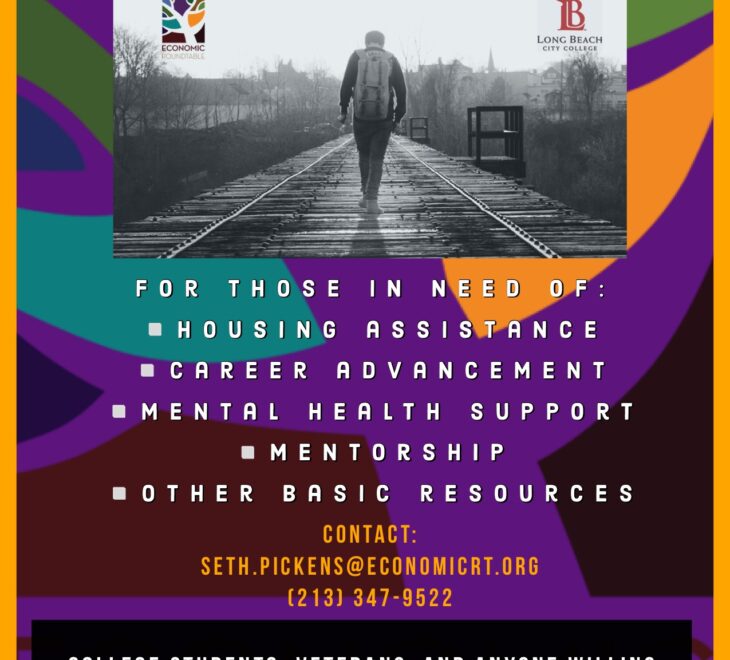FOR IMMEDIATE RELEASE: Thursday, February 15, 2024
CONTACT: Daniel Flaming, danflaming@economicrt.org, (213) 892-8104 or Seth Pickens, seth.pickens@economicrt.org
Early Intervention, Comprehensive Help and Jobs Are Key To Stemming Chronic Homelessness
By addressing homelessness as an issue of economic opportunity and human potential, rapid re-employment programs can bring homeless workers back into the labor force and help them thrive.
LOS ANGELES – Unemployment and lack of income are by far the most common reasons that homeless individuals living on Los Angeles streets give for being unhoused. Homelessness is an income problem. Employment has proven to be an effective tool for providing income, dignity and housing for homeless individuals.
In 2020, the Economic Roundtable launched the Realization Project, which is the first rapid re-employment program that uses predictive screening tools to target workers who have a high risk of becoming persistently homeless. This made it possible to prevent chronic homelessness before it occurred rather than after the fact.
The recently concluded project used the screening tools to identify and help community college students at Long Beach City College who had a high risk of being persistently homeless. These evidence-based tools combine the predictive power of 49 pieces of information about an individual’s attributes and personal history. Participants in the project received whole-person, comprehensive help. Outcomes are described in the just-released report, The Work Behind Work: Combatting Homelessness with Jobs.
“Housing alone is not enough to end homelessness. The steady flow of new people into chronic homelessness keeps moving the goalposts back,” said Daniel Flaming, president of the Economic Roundtable. “Over two-thirds of newly homeless individuals in Los Angeles are working or actively looking for a job. By providing help, including jobs, during the first chapter of homelessness, we can dramatically stem the flow of people into chronic homelessness.”
Ninety-five percent of participants had stable housing after they left the Realization Project. Their employment rate was 41 percent higher when they left the program than when they entered. The average post-project wage for all of the employed participants was $20.69, and 18 percent are earning more than $25 per hour.
The project provided 10 months of help that included career training, case management, childcare, behavioral healthcare, temporary housing, support for basic needs, socioemotional support, and help in getting a job.
The average cost was $17,150 for each participant, which is virtually the same as one year of public costs for demographically comparable counterparts who did not receive help. The difference is that the counterparts who did not receive help are likely to need costly public services year after year. In contrast, most Realization Project participants developed life-changing capabilities to act with greater self-determination and competence for achieving their goals for employment and housing stability.
The evidence from the Realization Project shows that it is important to intervene early with a full array of supports. It shows that a stronger commitment to upstream interventions that lead to employment will significantly reduce the number of men, women and children who experience homelessness.
“Homelessness results from system-wide failures and requires broader system-wide engagement to provide jobs. Homelessness is a moral crisis that will define our civic legacy in the eyes of future generations,” Seth Pickens, director of the Realization Project said. “Well-paying jobs lift people out of homelessness and applied hopefulness lifts people into well-paying jobs.”
The Economic Roundtable report cautions against diverting resources from housing chronically homeless individuals and recommends creating parallel efforts to intervene early with targeted employment assistance to reduce the flow of people into chronic homelessness.
The Realization Project demonstrated that it is feasible to help many homeless individuals get an anchor in the job market and that this costs much less than the cost of permanently subsidized housing or the cost of ongoing public services if individuals remain homeless. Scaling-up employment interventions can have an immediate impact on reducing the number of people who do not have a place of their own to sleep.
Looking into the future, a Realization Project participant said, “I’m the first person in my family to attend college, and later this year, I will be the first one to graduate! I’m also a new father. I have the skills, I’m punctual to a fault, and I’m highly motivated to get my career going.”
############
The Economic Roundtable is a nonprofit urban research organization based in Los Angeles that carries out large-scale data analyses to identify actionable solutions to social, economic and environmental problems. To learn more, please visit https://economicrt.org
“The Work Behind Work,” feature image of man sitting backwards on horse, Henri de Toulouse-Lautrec, 1899, Au Cirque Jockey (At the Circus Jockey), Harvard Museum.













